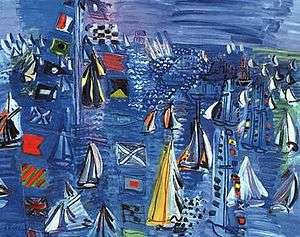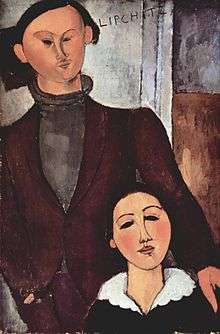School of Paris

School of Paris (French: École de Paris) refers to a group of French and émigré artists who worked in Paris between the first years of the 20th century and the 1950s.

The School of Paris was not a single art movement or institution, but it demonstrated the importance of Paris as a center of Western art in the early decades of the 20th century. Between 1900 and 1940 the city was a magnet for artists from all over the world and a centre for artistic activity. School of Paris was used to describe this broad affiliation, particularly of non-French artists.[1]
Early Artists
Before World War I, a group of expatriates in Paris created in the styles of Post-Impressionism, Cubism and Fauvism. It included artists like Pablo Picasso, Marc Chagall, Amedeo Modigliani and Piet Mondrian. Associated French artists included Pierre Bonnard, Henri Matisse, Jean Metzinger and Albert Gleizes. Picasso and Matisse have been described as the twin leaders (chefs d’école) of the school.[2]
The term "School of Paris" was coined in 1925 by André Warnod to celebrate the contribution of the many foreign-born artists who had recently migrated to Paris. The term soon gained currency, often as a derogatory label used by critics who regarded the foreign artists—a large number of whom were Jewish—as a threat to "the purity and continuity of the French tradition. After World War II, however, these nationalistic and anti-Semitic attitudes were discredited, and the term acquired a more general use to denote both foreign and French artists working in Paris."[3]
Many of these artists, as well as Jean Arp, Robert Delaunay, Sonia Delaunay, Joan Miró, Constantin Brâncuși, Raoul Dufy, Tsuguharu Foujita, artists from Belarus including Michel Kikoine, Pinchus Kremegne, Ossip Zadkine, Jacques Lipchitz, Polish artist Marek Szwarc and others including the Russian-born prince Alexis Arapoff,[4] worked in Paris between World War I and World War II, in various styles including Surrealism and Dada. A significant group of Jewish artists came to be known as the Jewish School of Paris. This group included Emmanuel Mané-Katz, Chaïm Soutine, Adolphe Féder, Chagall, Moïse Kisling, Shimshon Holzman and Jules Pascin.[5] The Musée d'Art et d'Histoire du Judaisme has works from artists such as Pascin, Michel Kikoine, Soutine, and Jacques Lipschitz.
Musicians
In the same period, the School of Paris name was also extended to an informal association of classical composers, émigrés from Central and Eastern Europe to who met at the Café Du Dôme in Montparnasse. They included Alexandre Tansman, Alexander Tcherepnin, Bohuslav Martinů and Tibor Harsányi. Unlike Les Six, another group of Montparnasse musicians at this time, the musical school of Paris was a loosely-knit group that did not adhere to any particular stylistic orientation.[6]
Après-guerre
After the Second World War the term "School of Paris" often referred to tachisme, and lyrical abstraction, a European parallel to American abstract expressionism. These artists are also related to CoBrA. Important proponents were Jean Dubuffet, Zoran Mušič, Pierre Soulages, Nicolas de Staël, Hans Hartung, Serge Poliakoff, Bram van Velde, Georges Mathieu, Jean Messagier, Jean-Michel Coulon among others. Many of their exhibitions took place at the Galerie de France in Paris, and then at the Salon de Mai.
Gallery
%2C_oil_on_canvas%2C_44.8_x_36.8_cm%2C_Korban_Art_Foundation..jpg) Jean Metzinger, Femme au Chapeau (Woman with a Hat), c.1906, oil on canvas, 44.8 x 36.8 cm, Korban Art Foundation
Jean Metzinger, Femme au Chapeau (Woman with a Hat), c.1906, oil on canvas, 44.8 x 36.8 cm, Korban Art Foundation%2C_oil_on_canvas%2C_private_collection.jpg) Marc Chagall, Still-life (Nature morte), 1912, oil on canvas, private collection
Marc Chagall, Still-life (Nature morte), 1912, oil on canvas, private collection Robert Delaunay, Simultaneous Contrasts: Sun and Moon, 1912–13, oil on canvas, The Museum of Modern Art, New York City
Robert Delaunay, Simultaneous Contrasts: Sun and Moon, 1912–13, oil on canvas, The Museum of Modern Art, New York City Moïse Kisling, Nu sur un divan noir, 1913, oil on canvas, 97 x 130 cm
Moïse Kisling, Nu sur un divan noir, 1913, oil on canvas, 97 x 130 cm Amedeo Modigliani, Portrait of Chaïm Soutine, 1916
Amedeo Modigliani, Portrait of Chaïm Soutine, 1916 Amedeo Modigliani, Jacques and Berthe Lipchitz, 1916
Amedeo Modigliani, Jacques and Berthe Lipchitz, 1916 Jacques Lipchitz, Portrait of Jean Cocteau, 1920
Jacques Lipchitz, Portrait of Jean Cocteau, 1920_-_Mus%C3%A9e_d'art_et_d'histoire_du_Juda%C3%AFsme.jpg) Chaim Soutine, Céret Landscape, c. 1920, oil on canvas, 55 x 65 cm, Musée d'Art et d'Histoire du Judaïsme
Chaim Soutine, Céret Landscape, c. 1920, oil on canvas, 55 x 65 cm, Musée d'Art et d'Histoire du Judaïsme
See also
References
- ↑ "School of Paris". Heilbrunn Timeline of Art History. The Metropolitan Museum of Art. Retrieved July 16, 2014.
- ↑ "Glossary of art terms: School of Paris". Tate Gallery. Retrieved July 16, 2014.
- ↑ Alley, Ronald. "Ecole de Paris." Grove Art Online. Oxford Art Online. Oxford University Press. Web.
- ↑ Boston College University Libraries
- ↑ Schechter, Ronald; Zirkin, Shoshanna (2009). "Jews in France". In M. Avrum Ehrlich (Ed.). Encyclopedia of the Jewish Diaspora: Origins, Experiences, and Culture. 3. Santa Barbara, CA: ABC-CLIO. pp. 820–831; here: 829. ISBN 9781851098736. Retrieved December 22, 2016.
- ↑ Korabelʹnikova, Li͡udmila Zinovʹevna (2008). "European Destiny: The Paris School". Alexander Tcherepnin: The Saga of a Russian Emigré Composer. Indiana University Press. pp. 65–70. ISBN 0-253-34938-9.
Further reading
- West, Shearer (1996). The Bullfinch Guide to Art. UK: Bloomsbury Publishing. ISBN 978-0-8212-2137-2.
- Nieszawer, Nadine (2000). Peintres Juifs à Paris 1905-1939 (in French). Paris: Denoel. ISBN 978-2-207-25142-3.
External links
| Wikimedia Commons has media related to École de Paris. |
- (in French) (in English) Nadine Nieszawer's website, dedicated to the School of Paris 1905-1939 (includes many biographies)
- The Second Spanish School of Paris
- Website for Jewish art of the School of Paris circle
- school-of-paris.org : community website open to any fan to Ecole de Paris in the world
- The School of Paris 1945 – 1965